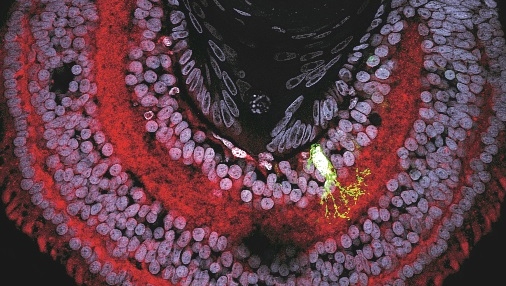If you ask frequent users of Cannabis about the way they feel after using marijuana, most of them will express how much this plant represents a source of wellbeing and comfort to them. And yet, we all know that the effect of cannabis on the human body is much more complex than that. In this post, we explore the science and research behind the effects of cannabis on human vision.
I. The happy red-eyed tribe
One of the most prominent rapid effect of Cannabis is noticeable in the eyes of the users. As most of the literature portraits – red eyes – is described as the visible effect of a large dose of Cannabinoids in the blood stream. And this is actually true.
 Anonymous subject after abundantly vaping ‘Purple Punch’ Cannabis strain from Jungle Boys
Anonymous subject after abundantly vaping ‘Purple Punch’ Cannabis strain from Jungle Boys
II. Why does Cannabis turn people’s eyes red?
The smoke Cannabis has no more mechanical effects on the eyes than tobacco does, it could occasionally irritate the eyes of the user but the answer is elsewhere: Cannabinoids.
 THC Delta-9 Molecule
THC Delta-9 Molecule
And the guilt lies on the shoulders of the famous THC Delta9 compound. While lowering the general blood pressure in the body the THC simply causes the capillary blood vessels in the eyes to dilate too. As the blood flow increases in larger vessels it creates a red pattern like a red texture on the top of the eye balls. Such symptoms can be observed after vaping or ingesting Cannabis too, showing if necessary that the smoke itself is not enough not create the red eyes effect.
Now the positive side of this effect is that reducing intraocular pressure is exactly what it takes to ease the treatment of the Glaucoma affection. The alternatives to Cannabis for this condition are expensive eye-drops, micro surgery, and laser surgery.
But the studies do report that the average level of THC necessary to induce a significant lowering of the intraocular pressure is so high that most of the patients who are no used to THC and Cannabis daily, can’t cope with the psychoactive effects caused by THC (inability to drive, reduced concentration, etc.
“..most of the glaucoma patients can’t cope with the effects of THC”

III. Does Cannabis have a negative effect on the human vision?
A recent study led by the Pole Hospitalo-Universitaire de Psychiatrie du Grand Nancy, Laxou, France, has shown there was “a delay of approximately 10 milliseconds in the transmission (…) along the visual pathway via the optic nerve”.
Translated in human language this means the use of Cannabis tends to slow down the transmission of the message between the surface of the eye and through the optic nerve to the bottom of the eye system.
It should be said however that this study was conducted with a sample size of 52 individuals. The conclusion was that “the statement that cannabis causes dysfunction cannot be made with any degree of certainty.” The study was unable to establish whether the latency was permanent or temporary only.
IV. The Tadpoles Experiment.
In another study led by Loïs S Miraucourt from the Montreal Neurological Institute, McGill University, Canada the conclusion was that cannabis produces an “enhanced visual contrast sensitivity (…) and a (…) remarkable improvement in the visual detection of dim objects.”
 Actual Tadpoles on THC Experiment picture
Actual Tadpoles on THC Experiment picture
This time, the test subjects were tadpoles under THC. Assuming the human eye’s behaviour would behave identically more clinical tests implicating human subjects are expected in 2018 in several other universities like the one in Tel-Aviv and in the US.
V. Cannabis: The fisherman’s best friend? (even if it’s a bit strong)
Some 25 years ago the pioneer pharmacologist Professor Manley Elisha West of Jamaica began his studies on the Glaucoma affection.
 Professor Manley West
Professor Manley West
Dr. Manley West is an emeritus professor and administrator who were running a pharmacology lab at the University of the West Indies (UWI) campus in Kingston. He has worked with ophthalmologist Dr Albert Lockhart on pioneering research that turns raw ganja into specialty medicines for glaucoma and other disorders.
In 1971 the professor began his studies while observing the Jamaican fisherman. “The local fishermen were telling us that smoking Ganja could noticeably improve their night vision. Some others said it was just a feeling. But we looked into this, and we found out that Cannabis was interacting with the blood stream towards the eye’s retina.” Said ME West.

“we found out that Cannabis was interacting with the blood stream towards the eye’s retina”
 The scientist received two of Jamaica’s highest medical honors: the Order of Merit for Medicine and the Musgrave Gold Medal. His studies led to a major breakthrough in order heal Glaucoma as they invented the Canasol®.
The scientist received two of Jamaica’s highest medical honors: the Order of Merit for Medicine and the Musgrave Gold Medal. His studies led to a major breakthrough in order heal Glaucoma as they invented the Canasol®.
The Canasol received a legal certificate of approval from the Jamaican government in February 1983.
VI. Professors Merzouki and Molero Mesa in Morocco
Most recently, another study led by Professor Merzouki, Professor Molero Massa, Professor Russo, Professor Frey and Professor Bach was conducted during a trip to the fishermen village of Chmaala, located on the Mediterranean coast about 100 km east of Tetouan, Morocco in July 1991.
in the original study
: “
The current study supports the previous ethnobotanical observations that cannabis may improve night vision. This effect seems to be dose-dependent and cannabinoid mediated.
Further study may reveal whether this clinical application of cannabis could be added to treatment of pain, spasticity of multiple sclerosis, and nausea of chemotherapy as recognized indications for this ancient substance.”
 Fisherman in Merja Zerga, Morocco 1976
Fisherman in Merja Zerga, Morocco 1976
VII. Scientific studies and unexpected findings
Today it is scientifically admitted that “cannabinoids (…) reduce transmitter release from cones and bipolar cells.” The delay in the transmission of the signals between the surface and the bottom of the eye is precisely the mechanism that triggers the night vision improvement.
But a surprise finding from the University of Waterloo, University of Aukland and Brown University has found the prenatal exposure to Cannabis show a significant improvement in their ability to track moving objects at age four. Compared with other psycho active and toxic compounds, Cannabis is very likely to improve the development of human vision as it seems, not only at the sole level of the receptor and the transmitters, but at the level of signal processing and analysis too. This means the benefits of Cannabis on the human vision could come from interactions between Cannabinoids and the human brain too.
“Cannabis is very likely to improve the development of human vision.”
Even more disturbing the experience described by the journalist Sue Arnold wrote in The Observer in September 1997 of how smoking Skunk temporarily restored her vision.
 BBC Journalist Sue Arnold
BBC Journalist Sue Arnold
“All I remembered about that evening…was the sudden clarity with which I could see everything, as if someone had switched on a 150-watt light bulb”
Studies have confirmed that Cannabis improves night vision and considerably reduces the effects on Glaucoma on the human eye. That said, one potential downside was found in a recent study by the FDA.
A 2017 FDA study reports finds out 0.23% of a test population are developing light sensitivity while using Cannabis. The symptoms are most likely to affect female between 20-29 years old.
We couldn’t find further contradictory studies about Cannabinoids involving any particular problem with light sensitivity. The opposite way around every scientific data available tend to show that Cannabis improves retinal sensitivity and low-light vision. The accidental findings suggest that cannabis should be beneficial for treating degenerative eye diseases and improving motion tracking and contrast in the human eye.
Sources
https://www.medicalmarijuanainc.com
https://media.jamanetwork.com/
Jamaican named UWI Professor of Pharmacology. December 12, 1981.
References
- B/N -West, Manley (National Library of Jamaica file)
- H/N -University of the West Indies-Medical Faculty (National Library of Jamaica file)
- “Research for Development” University of the West Indies, 2009
- “Remembering a Pioneer, Mentor and Friend”. West Indian Medical Journal.16.2 (2012).
- Obituaries. The Gleaner. Wednesday May 2, 2012.
- “Manley West, a pioneer in Bio-chemistry.” The Gleaner. Monday March 1, 1999









